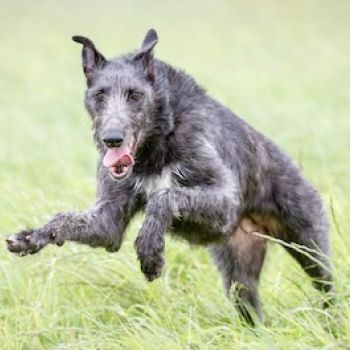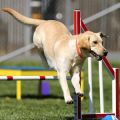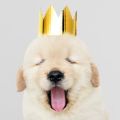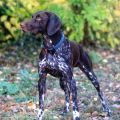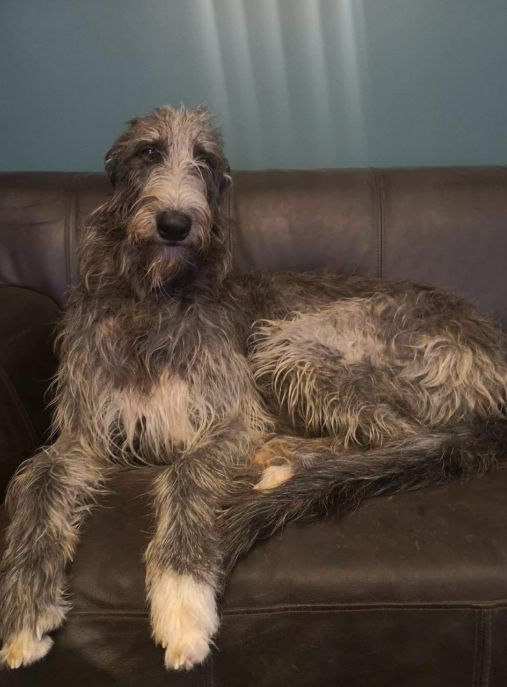The Deerhound, also known as the Scottish Deerhound, is a majestic and noble breed of dog that has captured the hearts of many dog enthusiasts around the world. With its regal appearance, graceful movement, and gentle nature, the Deerhound is truly a sight to behold. In this text, we will delve into the history, characteristics, and interesting facts about this remarkable breed.
Originating from Scotland, the Deerhound has a rich history that dates back centuries. It is believed to have descended from ancient coursing hounds that were used by the Scottish nobility for hunting deer. These dogs were highly valued for their exceptional speed, agility, and endurance, which made them well-suited for chasing down and capturing game.
The Deerhound belongs to the Hound group according to the FCI (Fédération Cynologique Internationale) typology. This group includes breeds that are primarily used for hunting, either by scent or sight. Within the Hound group, the Deerhound falls into the Sighthound section, which comprises breeds that rely on their keen eyesight to track and pursue prey.
In terms of purpose, the Deerhound is primarily a hunting breed, specifically bred for coursing and capturing deer. However, over time, their role has evolved, and they have become cherished family companions and show dogs. Their gentle and affectionate nature makes them excellent companions, and their calm demeanor makes them well-suited for households with children and other pets.
In terms of physical characteristics, the Deerhound is a large breed with a lean and muscular build. Males typically stand between 30 to 32 inches (76 to 81 cm) at the shoulder, while females are slightly smaller, ranging from 28 to 30 inches (71 to 76 cm). Their weight can vary between 75 to 110 pounds (34 to 50 kg), with males being larger and heavier than females.
One of the most distinctive features of the Deerhound is its long and shaggy coat, which provides protection against the harsh Scottish climate. The coat can come in various colors, including blue-gray, brindle, fawn, and sandy red. Regular grooming is necessary to maintain the coat's health and prevent matting.
The Deerhound has a relatively short lifespan compared to some other breeds, averaging between 8 to 10 years. However, with proper care, nutrition, and regular exercise, they can live longer and healthier lives. It is important to note that larger breeds, such as the Deerhound, are more prone to certain health issues, including bloat, hip dysplasia, and heart problems. Regular veterinary check-ups and a balanced diet are essential for their overall well-being.
Despite their size, Deerhounds are known for their gentle and friendly temperament. They are generally good-natured, loyal, and affectionate towards their families. However, due to their hunting instincts, they may exhibit a strong prey drive and should be supervised around smaller animals. Early socialization and training are crucial to ensure they grow up to be well-behaved and obedient companions.
While the Deerhound is a relatively rare breed, it has gained popularity among dog enthusiasts who appreciate its unique combination of elegance, athleticism, and gentle nature. They are not suitable for apartment living due to their size and exercise needs. A spacious, securely fenced yard is ideal for them to roam and stretch their legs.
In conclusion, the Deerhound is a remarkable breed with a fascinating history and exceptional characteristics. From its origins as a skilled deer hunter to its role as a beloved family companion, the Deerhound has proven to be a versatile and cherished breed. With its regal appearance, gentle temperament, and impressive athleticism, the Deerhound continues to captivate the hearts of dog lovers worldwide.

Deerhounds, also known as Scottish Deerhounds, are majestic and noble dogs with a character that is as impressive as their physical appearance. These gentle giants are known for their calm and dignified demeanor, making them a wonderful addition to any family. In this text, we will explore the character of Deerhound dogs, their behavior, and provide insights on how to raise and train them.
Deerhounds are renowned for their gentle and affectionate nature. They are incredibly loyal and form strong bonds with their human companions. These dogs thrive on human interaction and are known to be excellent family pets. Despite their large size, Deerhounds are surprisingly gentle and patient, especially with children. They have a natural instinct to protect and care for their loved ones, making them an ideal choice for families with young ones.
One of the defining characteristics of Deerhounds is their calm and laid-back temperament. They are not known to be hyperactive or overly excitable dogs. Instead, they possess a serene and composed disposition, which can be attributed to their history as hunting dogs. This calmness makes them well-suited for apartment living, as they are generally not prone to excessive barking or destructive behavior.
While Deerhounds are generally friendly and sociable, they can be reserved around strangers. They are not aggressive dogs by nature, but they may exhibit caution when encountering unfamiliar people or situations. Early socialization is crucial to ensure that they grow up to be well-rounded and confident dogs. Exposing them to various environments, people, and other animals from a young age will help them develop into sociable and well-behaved companions.
Training a Deerhound requires patience, consistency, and positive reinforcement. These dogs are intelligent and eager to please, but they can also be independent thinkers. It is important to establish yourself as the pack leader early on and provide clear boundaries and expectations. Positive reinforcement techniques, such as treats, praise, and rewards, work best with this breed. Harsh training methods or punishment can be counterproductive and may lead to a loss of trust and cooperation.
Deerhounds have a strong prey drive, which stems from their history as hunting dogs. It is essential to keep them on a leash or in a securely fenced area when outside, as they may be tempted to chase after small animals. Recall training should be a priority, and teaching them a reliable recall command will help ensure their safety.
Exercise is vital for Deerhounds to maintain their physical and mental well-being. Despite their calm demeanor, they are still sighthounds and possess a natural instinct to run and chase. Regular, long walks and opportunities for off-leash exercise in a safe and enclosed area are necessary to fulfill their exercise needs. However, it is important to avoid excessive exercise during their growth stages to prevent potential joint issues.
In conclusion, Deerhounds are gentle, loyal, and dignified dogs with a calm and composed temperament. They make excellent family pets and are particularly patient and protective of children. Early socialization, positive reinforcement training, and regular exercise are key to raising a well-behaved and happy Deerhound. With the right care and attention, these majestic dogs will bring joy and companionship to their families for many years to come.
Deerhounds are majestic and elegant dogs known for their grace, speed, and gentle nature. Caring for a Deerhound requires a combination of attention, exercise, grooming, and proper nutrition. Here are some tips on how to care for these magnificent dogs, including what to do and what not to do:
1. Exercise: Deerhounds are a large and active breed, so regular exercise is crucial. They require daily walks, preferably in a safe and secure area where they can run freely. However, avoid excessive exercise during their growth phase to prevent joint problems. Mental stimulation, such as puzzle toys or obedience training, is also important to keep their minds sharp.
2. Socialization: Early and ongoing socialization is vital for Deerhounds. They are generally friendly and sociable, but proper exposure to different people, animals, and environments will help them develop into well-rounded dogs. Introduce them to various situations gradually, ensuring positive experiences to build their confidence.
3. Grooming: Deerhounds have a wiry, rough coat that requires regular brushing to prevent matting. Use a slicker brush or a comb with wide teeth to remove loose hair and tangles. They shed moderately, so weekly brushing should suffice. Additionally, trim their nails regularly, clean their ears to prevent infections, and brush their teeth to maintain good oral hygiene.
4. Feeding: Provide a balanced and nutritious diet suitable for large breeds. Feed them high-quality dog food formulated for their specific needs, considering their age, activity level, and any health concerns. Avoid overfeeding, as Deerhounds can be prone to obesity, which can strain their joints. Consult with a veterinarian to determine the appropriate portion sizes and feeding schedule.
5. Health care: Regular veterinary check-ups are essential to monitor the overall health of your Deerhound. Vaccinations, parasite prevention, and dental care should be part of their routine. Deerhounds are generally a healthy breed, but they can be susceptible to certain genetic conditions such as bloat, heart disease, and bone cancer. Early detection and prompt treatment are crucial, so be vigilant for any signs of illness or discomfort.
6. Safety: Deerhounds have a strong prey drive, so it's important to keep them in a securely fenced yard or on a leash during walks. They may chase small animals, so be cautious around cats or other small pets. Additionally, provide them with a comfortable and safe space indoors, away from hazards like toxic plants or small objects they could swallow.
7. Training: Deerhounds are intelligent and eager to please, making them relatively easy to train. Use positive reinforcement techniques such as treats, praise, and play to motivate them. However, avoid harsh training methods or excessive punishment, as it can damage their sensitive nature and hinder their progress.
8. Companionship: Deerhounds thrive on human companionship and are known to be gentle and affectionate. They are not suited for a solitary lifestyle and may suffer from separation anxiety if left alone for extended periods. Ensure they receive plenty of love, attention, and quality time with their family members.
What not to do:
1. Do not leave your Deerhound alone for long periods without mental or physical stimulation.
2. Do not over-exercise them during their growth phase to prevent joint problems.
3. Do not neglect their grooming needs, as their coat can become matted and uncomfortable.
4. Do not use harsh training methods or punishment, as it can damage their sensitive nature.
5. Do not allow them off-leash in unfenced areas, as their prey drive may lead them to chase small animals.
By following these tips and providing the recommended care, you can ensure that your Deerhound remains healthy, happy, and well-adjusted throughout their life.
The common color of Deerhound dogs is a striking and captivating blend of various shades and tones that create a truly unique and beautiful appearance. The coat of a Deerhound is typically dense, wiry, and slightly rough to the touch, providing protection against the elements and giving them a regal and majestic appearance.
One of the most prevalent colors seen in Deerhounds is a stunning shade of gray. This gray can range from a light, silvery hue to a deeper, charcoal gray. The coat often has a natural sheen to it, adding to the overall elegance of the dog. The gray coloration is usually distributed evenly throughout the body, creating a harmonious and balanced look.
In addition to gray, Deerhounds can also exhibit various other colors that complement and enhance their overall appearance. Some individuals may have patches or markings of black or dark gray on their coat, adding depth and contrast to their appearance. These markings can be found on the face, ears, back, or legs, creating a visually appealing pattern.
Another color that can be seen in Deerhounds is a beautiful shade of brindle. Brindle is a unique color pattern characterized by a mix of dark and light stripes or streaks on a lighter background. In Deerhounds, the brindle pattern can vary in intensity, with some dogs having a more subtle pattern, while others may have a more pronounced and bold brindle coat.
It is not uncommon to find Deerhounds with a combination of colors, such as gray and brindle. This combination adds an extra layer of complexity and visual interest to their appearance. The interplay of different colors creates a mesmerizing effect, making each Deerhound truly one-of-a-kind.
The color of a Deerhound's coat can also be influenced by other factors such as age and individual genetics. As they age, some Deerhounds may develop a grizzled appearance, with their coat transitioning to a mix of gray and white. This aging process adds a touch of wisdom and maturity to their overall look.
Overall, the common color of Deerhound dogs is a captivating blend of gray, black, brindle, and white. Their coat is a testament to their grace and beauty, making them a truly remarkable breed. Whether it's the striking gray, the intricate brindle pattern, or the subtle mix of colors, the coat of a Deerhound is sure to leave a lasting impression on anyone fortunate enough to encounter these magnificent dogs.
The Deerhound, also known as the Scottish Deerhound, is a majestic and noble breed of dog that requires special attention to maintain its overall health and well-being. These dogs are known for their grace, athleticism, and gentle nature. However, like any other breed, Deerhounds are prone to certain health issues that owners should be aware of. In this text, we will explore the most common diseases found in Deerhounds and provide tips on how to care for their health.
One of the most prevalent health concerns in Deerhounds is dilated cardiomyopathy (DCM). This is a condition that affects the heart muscle, causing it to become weak and enlarged. Symptoms of DCM may include lethargy, coughing, difficulty breathing, and fainting. Regular veterinary check-ups and screenings can help detect this condition early on. A heart-healthy diet, regular exercise, and avoiding excessive stress are crucial for maintaining the cardiovascular health of Deerhounds.
Another common health issue in Deerhounds is gastric torsion, also known as bloat. This occurs when the stomach fills with gas and twists on itself, leading to a potentially life-threatening situation. Symptoms of bloat include restlessness, unproductive retching, distended abdomen, and rapid breathing. To prevent bloat, it is recommended to feed Deerhounds smaller, more frequent meals, avoid vigorous exercise immediately after meals, and use elevated feeding bowls.
Like many large breeds, Deerhounds are also prone to hip dysplasia. This is a genetic condition where the hip joint does not develop properly, leading to arthritis and mobility issues. Regular exercise on soft surfaces, maintaining a healthy weight, and providing joint supplements can help manage hip dysplasia. Additionally, responsible breeders should conduct hip evaluations on their breeding dogs to reduce the risk of passing on this condition to future generations.
Deerhounds are also susceptible to certain eye conditions, including progressive retinal atrophy (PRA) and cataracts. PRA is a degenerative disease that leads to gradual vision loss, while cataracts cause clouding of the lens. Regular eye examinations by a veterinary ophthalmologist can help detect these conditions early on. Unfortunately, there is no cure for PRA, but cataracts can often be surgically removed to restore vision.
To ensure the overall health of Deerhounds, it is essential to provide them with a balanced diet that meets their nutritional needs. High-quality dog food, preferably formulated for large breeds, should be the foundation of their diet. Regular exercise is also crucial to maintain their physical and mental well-being. Deerhounds are sighthounds and enjoy the opportunity to run freely in a secure, fenced area. However, it is important to avoid excessive exercise during their growth phase to prevent joint problems.
Regular veterinary check-ups, vaccinations, and preventive treatments for parasites such as fleas, ticks, and heartworms are essential for the health of Deerhounds. Dental care is also important, as these dogs are prone to dental issues. Regular brushing, dental chews, and professional cleanings can help prevent periodontal disease.
In conclusion, while Deerhounds are generally a healthy breed, they are prone to certain health conditions that require attention and care. Dilated cardiomyopathy, gastric torsion, hip dysplasia, and eye conditions are among the most common health concerns in Deerhounds. Regular veterinary check-ups, a balanced diet, exercise, and preventive measures are key to maintaining the health and well-being of these magnificent dogs.
The Deerhound, also known as the Scottish Deerhound, is a majestic and noble breed known for its grace, elegance, and athleticism. As a large and active dog, proper nutrition is essential to ensure their overall health and well-being. In this comprehensive guide, we will delve into the nutritional needs of Deerhounds, offering advice on feeding and highlighting foods to include and avoid.
Deerhounds are classified as a large breed, which means they have specific dietary requirements to support their growth, energy levels, and overall health. A balanced diet for a Deerhound should consist of high-quality proteins, healthy fats, complex carbohydrates, vitamins, and minerals. Here are some key considerations when it comes to feeding your Deerhound:
1. Protein: As an active breed, Deerhounds require a significant amount of protein to support their muscle development and repair. Look for dog food that contains high-quality animal-based proteins like chicken, beef, or fish. Aim for a protein content of around 25-30% in their diet.
2. Fats: Healthy fats are an important energy source for Deerhounds. Opt for dog food that includes sources of omega-3 and omega-6 fatty acids, such as fish oil or flaxseed oil. These fats promote a healthy coat, skin, and joint health.
3. Carbohydrates: Complex carbohydrates like whole grains, sweet potatoes, and brown rice provide sustained energy for your Deerhound. Avoid foods with excessive amounts of fillers or simple carbohydrates, such as corn or wheat, as they can lead to weight gain and digestive issues.
4. Fruits and Vegetables: Including a variety of fruits and vegetables in your Deerhound's diet can provide essential vitamins, minerals, and antioxidants. Some suitable options include carrots, green beans, blueberries, and apples. However, avoid feeding grapes, raisins, onions, and garlic, as they can be toxic to dogs.
5. Feeding Schedule: Deerhounds should be fed two to three meals per day to prevent bloating, a condition they are prone to. Divide their daily food intake into multiple smaller meals to aid digestion and reduce the risk of gastric torsion.
6. Portion Control: Deerhounds have a tendency to gain weight, so it's crucial to monitor their food intake and adjust portions accordingly. Consult with your veterinarian to determine the appropriate amount of food based on your dog's age, weight, and activity level.
7. Hydration: Always ensure your Deerhound has access to fresh, clean water throughout the day. Proper hydration is vital for their overall health and helps regulate body temperature.
While understanding what to include in a Deerhound's diet is important, it is equally crucial to be aware of foods that should be avoided:
1. Toxic Foods: Certain foods can be toxic to dogs and should never be fed to your Deerhound. These include chocolate, caffeine, alcohol, avocados, macadamia nuts, and anything containing xylitol (a sugar substitute).
2. Bones: Avoid feeding cooked bones to your Deerhound, as they can splinter and cause serious injuries or blockages. Instead, opt for raw bones specifically designed for dogs, which can help promote dental health.
3. Table Scraps: While it may be tempting to share your meal with your Deerhound, it's best to avoid feeding them table scraps. Human food often contains excessive salt, spices, and unhealthy fats, which can lead to digestive issues and obesity.
4. Allergenic Foods: Some Deerhounds may have food allergies or sensitivities. Common allergenic foods for dogs include wheat, corn, soy, and dairy products. If you suspect your dog has allergies, consult with your veterinarian to determine the best diet options.
In conclusion, providing a well-balanced and nutritious diet is essential for the health and vitality of Deerhounds. Remember to choose high-quality dog food with adequate protein, healthy fats, complex carbohydrates, and a variety of fruits and vegetables. Monitor portion sizes, avoid toxic foods, and consult with your veterinarian for personalized advice. By following these guidelines, you can ensure your Deerhound receives the optimal nutrition they need to thrive.


